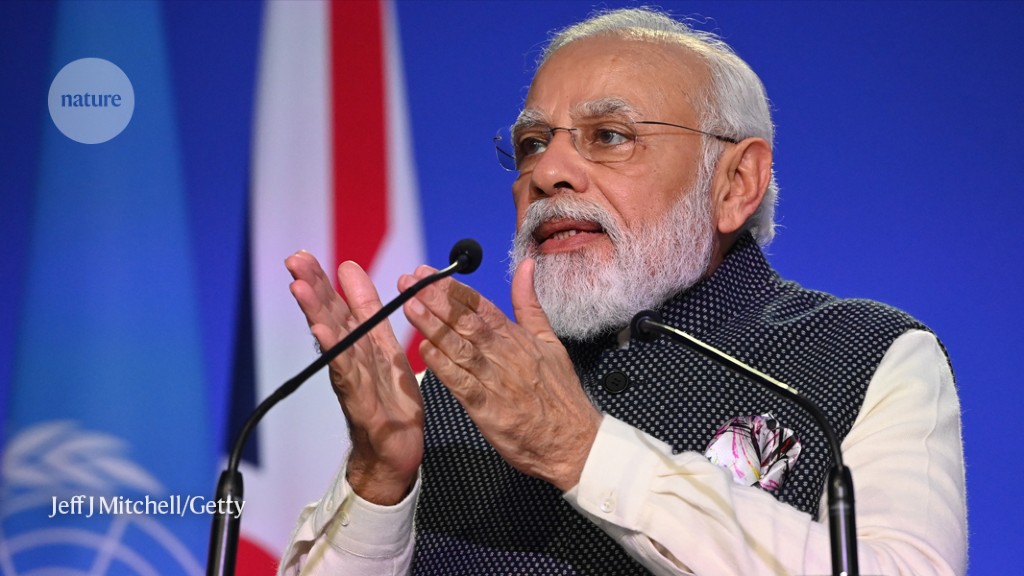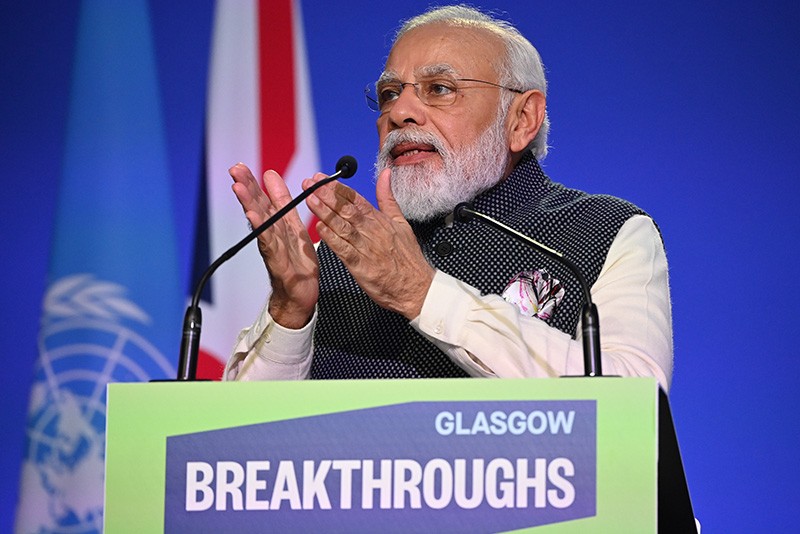India, the world’s third-biggest emitter of greenhouse gases, has pledged to achieve net-zero carbon emissions by 2070. The ambitious commitment, made on 1 November at the high-stakes COP26 climate meeting in Glasgow, UK, brings India in line with other big emitters, including the United States, China, Saudi Arabia and the European Union, which have made similar promises.
Although scientists welcome the offering — which could contribute to the world limiting global warming to 1.5 °C — they also caution that India’s pathway to carbon zero remains uncertain.
“It’s an ambitious target,” says Apurba Mitra, a climate-policy researcher in New Delhi with non-profit research organization the World Resources Institute. “It has put net-zero on the table.”
“It’s great; a very bold announcement,” adds Vaibhav Chaturvedi, an economist at New Delhi think tank the Council on Energy, Environment and Water, who works with the Indian government on climate modelling.
The surprise announcement came less than a week after some of India’s top politicians had said they would not set a deadline for when the nation might achieve net-zero emissions. Even most government officials had no idea it was coming, says Mitra.
Commitment and credibility
At COP26 — which runs for another week — Prime Minister Narendra Modi further promised that India would expand its renewable, hydro and nuclear power capacity to 500 gigawatts by 2030, and that half of the nation’s power-generating capacity would be based on renewable energy by that year. India will also reduce by one billion tonnes the carbon it is projected to emit this decade, he said, although the country has not yet made a formal submission to the United Nations Framework Convention on Climate Change.
The promises signal India’s commitment and credibility, says Navroz Dubash, a climate scientist at the Centre for Policy Research, a think tank in New Delhi. But the country now needs to lay out a clear road map for how it will achieve net zero — and establish monitoring mechanisms to ensure that emissions are falling, he says.
Modi did not specify what would be covered in India’s pledge — all greenhouse gases, or carbon dioxide alone. That detail has also been missing from some other nations’ initial net-zero pledges.
But the details matter, says Joeri Rogelj, director of research at the Grantham Institute for climate science at Imperial College London. Climate modelling shows that the world, on average, has to hit net-zero carbon dioxide emissions by 2050, and net-zero greenhouse-gas emissions by 2070, he says, to limit global warming to 1.5 °C above pre-industrial levels — the most aspirational goal of the 2015 Paris climate agreement.
If India’s target for 2070 refers to all greenhouse-gas emissions, it will help the world on its path to the 1.5 °C goal, he says. But, “given India’s development state, and its important needs to still lift large shares of its population out of poverty, this would be a very ambitious net-zero target for India”, adds Rogelj.
Important shift for India
However, experts think it is more likely that India’s plan is to reach net zero only for carbon dioxide by 2070, and not tie itself to commitments on other greenhouse gases. This would make it harder for the world to limit warming to 1.5 °C, he says. “This would be less ambitious, yet still an important shift in India’s perspective and how it visualizes its future,” Rogelj adds.
And the world could still hit the 1.5 °C target if low- and middle-income nations take longer to reach net-zero carbon dioxide, as long as wealthy nations set targets for even earlier than 2050, says Mitra.
Even hitting net-zero for carbon dioxide alone by 2070 is very ambitious for India, say climate-policy researchers who have been working with India’s government to model emissions-reductions scenarios.
The modelling is particularly complex and uncertain in the case of India, says Dubash. Most wealthy nations that have net-zero targets have already hit peak carbon emissions; their emissions are now beginning to fall, making it simpler to find downward trajectories.
But India is expanding its economy rapidly, and its emissions peak is nowhere on the horizon, says Dubash. Modellers must account for India’s emissions growth, find the probable peak and then explore pathways to net zero, he says.
All of this depends on how swiftly growing Indian cities will urbanize, populate and develop. “When you multiply out all these uncertainties, you end up with an enormous range of possible trajectories,” says Dubash.
Climate-modelling scenarios
A report published last month by Chaturvedi and his colleague Ankur Malyan explores an emissions peak in 2040, followed by net-zero carbon dioxide in 2070. The scenario includes a 99% reduction of coal-based power generation by 2060, an increase in solar capacity to 1,689 gigawatts by 2050 — enough to power hundreds of millions of homes — and the large-scale development of hydrogen as a fuel source, among other drastic shifts.
In a February report, the International Energy Agency modelled a scenario in which India hits net zero in the mid-2060s — a feat that, it notes, would require close to 200 gigawatts of battery capacity by 2040 to store solar and wind energy. That kind of capacity is unheard of globally at present.
Such choices would require research and development into battery storage, hydrogen technology and smart grids, says Chaturvedi, who notes that India’s net-zero announcement is a clear signal to industry that it should invest in decarbonization.
Perhaps the biggest limitation for now is that Indian currently has just a handful of climate modellers. “The capability is so limited,” says Chaturvedi, who says many more will be required to guide the policies of the state and national governments in coming decades.







More News
Could bird flu in cows lead to a human outbreak? Slow response worries scientists
US halts funding to controversial virus-hunting group: what researchers think
How high-fat diets feed breast cancer